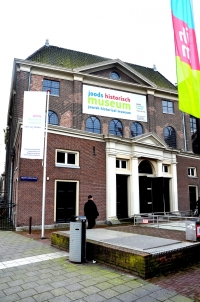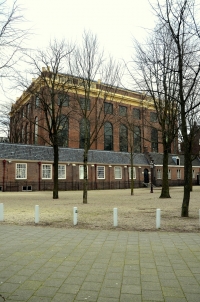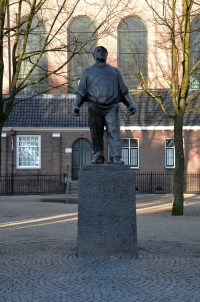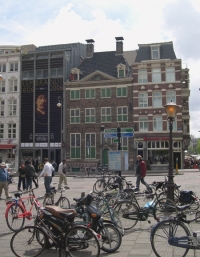Amsterdam Jewish Cultural Quarter
It is now more than half a century since the dark years of World War II ended, but the dramatic dimension of the Holocaust should not be forgotten. And while the modern Jewish areas of Amsterdam - South Amsterdam (Dutch: Zuid Amsterdam), Buitenveldert and Amstelveen prosper, in the Old Amsterdam Jewish neighbourhood (Dutch: Jodenbuurt) several institutions aim at preserving the memory of the past Jewish life and culture of the area. All these institutions are located in the vicinity of the Waterlooplein and the Plantage Middenlaan area.
Amsterdam Jewish history guided tour
The best way to learn about Jewish community and history in Amsterdam is through a walking tour with a knowledgeable personal guide. You can book such a tour through our main Jewish community webpage.
Participating institutions and memorial places:
 Jewish Historical Museum (Nieuwe Amstelstraat 1)
Jewish Historical Museum (Nieuwe Amstelstraat 1)
Four restored 17th and 18th Century Ashkenazi synagogues house this unique museum presenting not only the past but also the present time of the Jewish life, religion and culture. Its kosher cafe accessible without a museum ticket is a very good place to eat lunch.
Jewish Children Museum (Nieuwe Amstelstraat 1)
A wing within the Jewish Historical Museum houses a special exhibit about the Jewish traditions made especially for children. Jewish Children Museum also organizes attractive events for kids. During the day children from Amsterdam schools often visit the Children Museum so it may happen that you have to wait before your visit.
 Portuguese Synagogue (Mr. Visserplein 3)
Portuguese Synagogue (Mr. Visserplein 3)
One of the most beautiful synagogues of the world dating from 1675, this Sephardic synagogue is in fact a whole religious complex with the synagogue, archives, a mortuary, and a library (Ets Haim Library - see below).
Ets Haim Jewish Library (Mr. Visserplein 3)
Recently renovated Ets Haim Library (Livraria Montezinos) is located in the building adjoining the Portuguese Synagogue. Although not prepared to receive tourists, the library accepts the visitors upon appointment. Ets Haim Jewish Library has in its collection more than 25.000 books and 560 manuscripts in Hebrew, Spanish, Portuguese, Latin, Greek, Arabic and Yiddish. Some of the manuscripts date to13th C. For a guided tour please phone: +31 20 531 03 80; researchers please call +31 20 531 03 98
 February Protest Monument
February Protest Monument
(Jonas Daniël Meijerplein, on the right side from the entry to the Portuguese Synagogue)
A monument to commemorate the strike of the Amsterdam dock workers on February 24, 1941, to protest persecution of Jews. The strike has been followed by protest actions all over the city: in public transport, schools and in some companies. Strike actions also took place in several cities around Amsterdam and in Utrecht. Although the Nazi administration managed to suppress the strike within just a few days killing nine of the protesters, injuring many and perpetuating several other ruthless actions, the open protest against the Nazis had the symbolic importance for all people in the Netherlands. The monument represents a striking worker called ‘De Dokwerker”. The sculpture is by Mari Andriessen, a sculptor who during the war refused membership of the nazi-led artist union and hid himself Jewish friends at his home to save them from death.
Hollandse Schouwburg (Plantage Middenlaan 24)
A theater which during the German occupation served as the concentration place for the Amsterdam Jews before their deportation to the Nazi concentration camps, is today the main Holocaust monument in the city along with Anne Frank’s House.
Jewish Cultural Quarter - Open
The Jewish Cultural Quarter participating institutions have different opening days and hours. Please check on the webpage of your interest for the convenient time for your visit.
Admission
Tickets to all Jewish Cultural Quarter exhibits may be purchased at any of the participating institutions. Adults - € 12 ; young people age 13 -17, students, Stadspas - € 6 ; children age up to 13, Amsterdam Holland Pass, iAmsterdam Pass, Museum Card, Friends of The Jewish Historical Museum, ICOM, Rembrandt Association - free. Tickets are to the Jewish Historical Quarter are valid 1 month for a multiple access to all exhibits. Tickets to concerts at the Portuguese Synagogue: € 13.50
Other important points of interest in the former Jewish Quarter of Amsterdam:
The Pinto House (Sint Antoniebreestraat 69)
The house built in 1603, bought by the wealthy Jewish merchant Isaac de Pinto in 1651 and rebuilt by his son David Emanuel in 1686 with the broad classical facade. Devastated in 20th C. and saved from a demolition, it serves today as a public library. In principle not open to the public, it is still worthy of a look inside because of it's interesting old paintings on the ceilings.
Waterlooplein (Waterloo square)
Previously starting from 19th C. a Jewish cheap products market, today the biggest flea market in Amsterdam. Very touristy but worth a visit if you are interested in second hand books, used clothes or bicycle parts.
Gassan Diamonds (Nieuwe Uilenburgerstraat 173-175)
Traditionally Amsterdam has been a diamond cutting and trading city. Today the importance of this industry has diminished but one of the biggest remaining businesses - the Gassan Diamonds offers you the possibility of a free guided tour through their factory. Also a Jewellery shop and a locale for numerous special events. (daily 9 A.M. - 5 P.M.)
 The Rembrandt House (Jodenbreestraat 4-6)
The Rembrandt House (Jodenbreestraat 4-6)
A town house owned in the 17th C. by the famous Dutch painter Rembrandt van Rijn, located at the street which used to be the center of the Jewish life in the city. Although Rembrandt himself was not Jewish, his paintings often reflect his life among the Jews in the city - scenes from the Old Testament and many portraits of Amsterdam Jews. The Rembrandt House presents an exhibit about Rembrandt’s life, his epoch, an interesting collection of paintings by his contemporaries and his prints.
